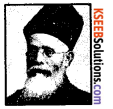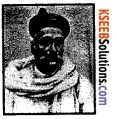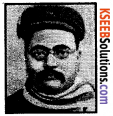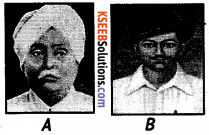Students can download Class 10 History Chapter 7 Freedom Movement Important Questions, KSEEB SSLC Class 10 Social Science Important Questions and Answers helps you to revise the complete Karnataka State Board Syllabus and score more marks in your examinations.
Karnataka SSLC Class 10 Social Science History Important Questions Chapter 7 Freedom Movement
Question 1.
What can be considered as the beginning of nationalism in India?
Answer:
Before the freedom movement began, we come across kings who fought against the foreign occupation. Though these were guided more by their political goals, since they fought against the foreign occupation it can be considered as the beginning of nationalism.
Question 2.
What developments took place in India during the second half of the nineteenth century?
Answer:
Expansion of communication and roads, expansion of English education and journalism, and the birth of cultural associations were some of the developments that took place in India during the second half of the nineteenth century.
Question 3.
How do you prove that people suffered hardships under the British?
Answer:
During the British rule people suffered a lot due to famines and the hardships caused by the rule. Many farmer and tribal agitations that took place during this period are a proof of this.
Question 4.
When did the First War of Indian Independence take place?
Answer:
The First War of Indian Independence took place in 1857.
Question 5.
What was the result of the First War of Indian Independence?
As a result of the First War of Indian Independence, the rule of the East India Company came to an end and the rule of the Queen of England began.
![]()
Question 6.
Which Act ensured the participation of Indians in the legislation proass?
Answer:
The Act of 1861 ensured the participation of Indians in the legislation process.
Question 7.
What were the consequences of the First War of Indian Independence?
Answer:
The First War of Indian Independence led to the development of political awakening in India. Many educated youth provided leadership to various
associations that had nationalistic outlook. As a result, nationalism found its root as a concrete concept.
Question 8.
What mav be considered as the institutional expression of the growth of nationalism in India?
Answer:
The founding of the Indian National Congress may be considered as the institutional expression of the growth of nationalism in India.
Question 9.
Mention some of the institutions started in India before 1885 that had nationalistic outlook.
(OR)
Which were the organisations formed in India before the founding of the Indian National Congress?
Answer:
Some of the institutions started in India before the establishment of the Indian National Congress (1885) that had nationalistic outlook were The Hindu Mela, All India Association, Poona Sarvajanik Sabha and The Indian Association.
Question 10.
Who enacted the Vernacular Press Act?
Answer:
The Vernacular Press Act was enacted by Lord Lytton.
Question 11.
Why was the Vernacular Press Act passed?
Answer:
The Vernacular Press Act was passed to curb the independence of the press.
Question 12.
The Vernacular Press Act was a major hurdle in the development of Indian journalism. Why?
Answer:
To curtail the freedom of the Indian press and prevent the expression of criticism towards British policies, Lord Lytton passed the Vernacular Press Act in 1878 which proved to be a major hurdle in the development of Indian journalism.
![]()
Question 13.
What were the circumstances that led to the establishment of the Indian National Congress?
Answer:
The First War of Indian Independence led to the development of political awakening in India. Many educated youth provided leadership to various associations that had nationalistic outlook. Newspapers opposed the Vernacular Press Act that was passed to curb the independence of the press. All these developments led to the establishment of the Indian National Congress.
Question 14.
When and where did the Indian National Congress come into existence?
Answer:
The Indian National Congress came into existence in 1885 at a national convention held at Bombay.
Question 15.
Who was the first President of the Indian National Congress?
Answer:
W.C. Banerjae was the first President of the Indian National Congress.
Question 16.
State the role played by A.O. Hume in the founding of the Indian National Congress.
Answer:
A.O. Hume, a retired British civil servant, played an important role in the formation of the Indian National Congress. He met Indian political leaders in cities like Madras, Bombay and Calcutta and discussed various issues of public importance. As a result of these deliberations the Indian National Congress declared achieving national unity its primary aim during the first national convention held at Bombay.
Question 17.
What role did the newspapers play in the freedom movement?
Answer:
The publication of newspapers in vernacular languages enabled discussion on various social and political issues. As a result, such issues reached the people.
Question 18.
Why did the British employ the policy of divide and rule?
Answer:
The British employed the divide and rule policy to break the emerging unity among the people with the development of nationalism. They started implementing strategies to cause disunity among Hindus and Muslims.
![]()
Question 19.
When and why was the Indian National Congress divided into Moderates and Radicab?
(OR)
On what basis were the Moderates and the Radicab identified?
Answer:
During the later part of the nineteenth century, differences of opinion arose in the Indian National Congress. Due to these differences in ideology, beliefs and execution styles, the Indian National Congress was divided into two groups, identified as Moderates and Radicals.
Question 20.
Which period is referred to as the Age of the Moderates?
Answer:
The first twenty years of the Indian National Congress, that is, from 1885 to 1905, is referred to as the Age of the Moderates.
Question 21.
Who were Moderates? Mention some of the Moderate leaders.
Answer:
The Congress leaders who believed in bringing about political change through constitutional means were called Moderates. W.C. Banerjee, M.G. Ranade, Surendranath Banerjee, Dadabhai Naoroji and Gopalakrishna Gokhale were some of the leaders of the Moderates.
Question 22.
What were the demands put forward by the Moderates to the British?
Answer:
The Moderates trusted the British administration and judiciary. They placed their requests before the government within the constitutional framework. Their demands related to cutting down of military expenditure, development of Indian industries, providing good education and implementing programmes for poverty alleviation. .
![]()
Question 23.
Explain the role of the Moderates in the freedom struggle.
Answer:
The first phase of the freedom struggle from 1885 to 1905 is known as the Age of Moderates. The Moderate leaders believed in constitutional methods and had faith in the British administration and judiciary. They tried to bring in political awareness among the people. They organised public meetings, discussed various burning issues and submitted memorandums to the government.
The memorandums related to cutting down of military expenditure, development of Indian industries, providing good education and implementing programmes for poverty alleviation. The Moderates were the first to study the ill-effects of the British rule. They explained the drain of resources of India into England and called it Drain Theory. Dadabhai Naoroji and R.C. Datt published books explaining the draining of Indian resources into England.
Question 24.
Which period is referred to as the Age of Liberal Nationausm?
Answer:
The period of Moderates is referred to as the Age of Liberal Nationalism.
Question 25.
Who put forth the Drain Theory?
Answer:
The Drain Theory was put forth by Dadabhai Naoroji.
Question 26.
Identify the person. What did he explain?
Answer:

The person in the picture is Dadabhai Naoroji. He explained the transfer or drain of wealth from India to England.
Question 27.
Explain the Drain Theory.
Answer:
Dadabhai Naoroji explained the transfer or drain of wealth from India to England through scientific statistics. He maintained that encouraging imports and reducing exports created a situation unfavourable to India leading to drain of wealth from India to England. This is known as the Drain Theory.
![]()
Question 28.
Who called the Moderates ‘Political Beggars’?
Answer:
The Radicals called the Moderates ‘Political Beggars’.
Question 29.
Who were Radicab?
Answer:
Radicals were the members of the Congress who opposed the soft stance of the Moderates towards the British.
Question 30.
Mention some leaders of the Radicals.
Answer:
Aurobindo Ghosh, Bipin Chandra Pal, Lala Lajpath Rai and Bal Gangadhar Tilak were some of the leaders of the Radicals.
Question 31.
What was the role of the Radicals in the freedom struggle?
Answer:
The Radicals criticised the soft stance of the Moderates towards the British. They opposed the partition of Bengal and began an agitation. The division of Bengal resulted in widespread protests across the country. The Swadeshi movement was a part of this agitation. The movement called for boycotting of foreign goods and the institutions that encourage it.
The Radicals encouraged the people to use Indian goods. They also attempted to organise the people through religious celebrations such as Ganesha.Shivaji and Durga festivals.Tilak declared, “Swaraj is my birthright and I shall have it.” Thus, the Radicals aimed at an independent India. Through his newspapers ‘Kesari’ in Marathi and ‘Maratha’ in English, Tilak called for the active participation of the people in the fight for freedom.
![]()
Question 32.
How did the Moderates differ from the Radicals?
Answer:
The Moderates and the Radicals differed in their plan of action, beliefs and the type of struggle adopted by them. The Moderates believed in bringing about political change through constitutional means. They had faith in British ruje and judiciary. They tabled their demands within the framework of the Constitution through prayers and requests. They educated the people about national issues and tried to create awareness in the minds of the people.
They organised public meetings, discussed various issues and submitted memorandums to the government. The Radicals, on the other hand, were the members of the Congress who propagated extremist ideas. They opposed the British rule. They encouraged the people to fight against the British. Attaining complete independence was the aim of the Radicals.
Question 33.
When and by whom was Bengal partitioned?
Answer:
Bengal was partitioned in 1905 by the Viceroy Lord Curzon.
Question 34.
What were the reasons for the partition of Bengal?
Answer:
Bengal, at the beginning of the 20th century, was the centre of anti-British protests. In order to suppress these protests, the Viceroy Lord Curzon proposed a plan to divide Bengal citing administrative reasons. According to this plan, Bengal was to be divided into two – East Bengal with a Muslim majority and West Bengal with a Hindu majority. Thus, by creating differences between the Hindus and the Muslims, the British tried to suppress the spirit of the freedom struggle.
![]()
Question 35.
What was the reaction of Indians to the division of Bengal?
(OR)
Why was the division of Bengal withdrawn?
Answer:
The division of Bengal in 1905 by Lord Curzon was opposed by the Radicals. Protests against the division were organised throughout the country. The Swadeshi movement was very important among these protests. The movement called for boycotting of foreign goods and the institutions that encourage it. They encouraged the people to use local goods. As a result of these protests the government had to withdraw the division of Bengal.
Question 36.
In which year was the division of Bengal withdrawn?
Answer:
The division of Bengal was withdrawn in 1911.
Question 37.
Explain the role of Bal Gangadhar Tilak in the freedom struggle.
Answer:
Bal Gangadhar Tilak was the foremost leader of the Radicals in the Congress. He disliked the methods of the Moderates. He declared ‘Swaraj is my birth right’. He used functions like Ganesha festival and Shivaji’s birthday celebrations to organise the common people and to instill the spirit of freedom in them.
He also published ‘Kesari’, a newspaper in Marathi and ‘Maratha’, a newspaper in English. Through these newspapers he tried to spread awareness among the people about the freedom struggle. He was imprisoned for his revolutionary articles and activities. While in prison he wrote a book‘Geetarahasya’which further fuelled the freedom fervour.
Question 38.
Name the newspapers started by Bal Gangadhar Tilak.
Answer:
‘Kesari’ in Marathi and ‘Maratha’ in English were the newspapers started by Bal Gangadhar Tilak.
![]()
Question 39.
Name the book written by Bal Gangadhar Tilak.
Answer:
Bal Gangadhar Tilak wrote the book ‘Geetarahasya’.
Question 40.
- Name the person in the picture,
- Name the book written by him.
Answer:

The person in the picture is Bal Gangadhar Tilak. He wrote the book‘Geetarahasya.
Question 41.
Which were the functions organised by Bal Gangadhar Tilak to awaken nationalistic feeUngs among the people?
Answer:
Bal Gangadhar Tilak organised Ganesha festival and Shivaji birthday celebrations to awaken nationalistic feelings among the people.
Question 42.
Why was Bal Gangadhar Tilak arrested by the British?
Answer:
Bal Gangadhar Tilak was the foremost leader of the Radicals in the Congress. He declared ‘Swaraj is my birth right’. He used functions like Ganesha festival and Shivaji’s birthday celebrations to organise the common people and to instill the spirit of freedom in them. Through his newspapers ‘Kesari’ and ‘Maratha’ he tried to spread awareness among the people about the freedom struggle. Hence he was imprisoned by the British for his revolutionary articles and activities.
Question 43.
When and why was the Muslim League formed?
Answer:
The Muslim League was formed in 1906 to protect the Muslim identity.
![]()
Question 44.
Who were Revolutionaries?
Answer:
Revolutionaries were small groups which operated secretly to throw the British out of the country by employing violent methods.
Question 45.
Name the important Revolutionary leaders.
Answer:
V.D. Savarkar, Aurobindo Ghosh, Ashwini Kumar Datta, Rajanarayana Bose, Shivaram Rajaguru.Chapekar brothers, Vishnu Shastri,Champukar,Shyamji Krishna Varma, Ras Bihari Bose, Madam Cama.Kudhiram Bose, Ram Prasad Bismil,Ashfaqulla Khan.Bhagat Singh, Chandrashekar Azad and Jatindra Nath Das were some of the important Revolutionary leaders.
Question 46.
Mention some of the secret organisations established by the Revolutionaries.
Answer:
Lotus and Dagger in England, Ghadar Party in U.S.A., Abhinav Bharat, Anushilan Samiti were some of the secret organisations established by the Revolutionaries.
![]()
Question 47.
Mention two secret organisations established by the Revolutionaries in India.
Answer:
Abhinav Bharat and Anushilan Samiti were two of the secret organisations established by the Revolutionaries in India.
Question 48.
Explain the role of the Revolutionaries in the freedom struggle.
Answer:
The Revolutionaries dreamt of a completely free India. They believed that the British could be thrown out of India only by violent means. They established secret organisations not only across the country but also abroad. They collected money, bought weapons and trained their members for an armed struggle against the British.
Abhinav Bharat and Anushilan Samiti were two important organisations of this kind. They used bombs and guns to achieve their goal. Many of them were arrested and imprisoned. Some of them were even hanged. But the goal of achieving freedom through forceful means by the Revolutionaries did not materialise. However, they were a powerful source of inspiration for the freedom movement.

Question 49.
Identify the person in the picture. To which section of the Congress did he belong?
Answer:
The person in the picture is Gopal Krishna Gokhale. He belonged to the Moderates section of the Congress.A Person A’ in the picture is Lala Lajpat Rai. He belonged to the Radical group of the Congress. Person ‘B’ in the picture is Bhagat Singh. He belonged to the Revolutionary section of the Congress.
Question 50.
Identify persons A and ‘B’ represented in the picture. To which section of the Congress did each of them belong?
Answer:
Person A’ in the picture is Lala Lajpat Rai. He belonged to the Radical group of the Congress. Person ‘B’ in the picture is Bhagat Singh. He belonged to the Revolutionary section of the Congress.

Multiple-choice Questions:
Question 1.
Maratha newspaper was published by –
(A) Jawaharlal Nehru
(B) Ras Bihari Bose
(C) Bal Gangadhar Tilak
(D) V.D. Savarkar
Answer:
(C) Bal Gangadhar Tilak
Question 2.
The period from 1885 to 1905 is referred to as the –
(A) Age of the Radicals
(B) Age of the Revolutionaries
(C) Age of the Moderates
(D) Age of Nationalism
Answer:
(C) Age of the Moderates
Question 3.
Muslim League was founded in –
(A) 1924
(B) 1922
(C) 1929
(D) 1906
Answer:
(D) 1906
![]()
Question 4.
The Viceroy who implemented the division of Bengal was –
(A) Lord Cornwallis
(B) Dalhousie
(C) Lord Curzon
(D) Robert Clive
Answer:
(C) Lord Curzon
Question 5.
Who among the following was not a leader of the Moderates?
(A) M.G. Ranade
(B) Aurobindo Ghosh
(C) W.C. Banerjee
(D) Surendranath Banerjee
Answer:
(B) Aurobindo Ghosh
Question 6.
The leader of the Radicals among the following was –
(A) Dadabhai Naoroji
(B) Chandrashekar Azad
(C) Gopal Krishna Gokhale
(D) Bal Gangadhar Tilak
Answer:
(D) Bal Gangadhar Tilak
Question 7.
The Drain Theory was propounded by –
(A) Gopal Krishna Gokhale
(B) W.C. Banerjee
(C) Dadabhai Naoroji
(D) Surendranath Banerjee
Answer:
(C) Dadabhai Naoroji
Question 8.
The division of Bengal took place in the year –
(A) 1905
(B) 1906
(C) 1911
(D) 1904
Answer:
(A) 1905
![]()
Question 9.
The British government withdrew the division of Bengal in –
(A) 1908
(B) 1911
(C) 1905
(D) 1910
Answer:
(B) 1911
Question 10.
Tilak started a newspaper in Marathi called –
(A) Maratha
(B) Geetarahasya
(C) Satyartha Prakasha
(D) Kesari
Answer:
(D) Kesari
Question 11.
The purpose of dividing Bengal in 1905, according to Indians was –
(A) to divide Hindus and Muslims
(B) to support anti-British protests
(C) to develop the western part of Bengal
(D) to provide basic amenities to the people.
Answer:
(A) to divide Hindus and Muslims
Fill in the blanks:
- The Indian National Congress was founded in the year 1885
- The Drain Theory was put forward by Dadabhai Naoroji
- Swaraj is my birth right’ was declared by Bal Gangadhar Titak
- BaL Gangadhar Tilak published Kesari newspaper in Marathi.
- Abhinav Bharat was a secret organisation formed in India
- The ruLe of the East India Company came to an end in 1858
- The participation of Indians in the legisLation process was ushered in by the Act of 1861
- The VernacuLar Press Act was enacted by Lord Lytton
- The first President of the Indian National Congress was WC. Banerjee
- The division of Bengal took place in the year 1905
- The book written by Bal Gangadhar TiLak in prison was Geetarahasya